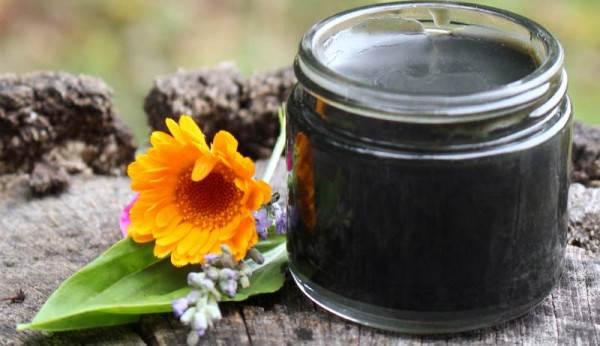

Some of us grew up with a grandma or great-grandma who kept a jar of black salve on hand for all manner of skin ailments. Every family had their own special recipe, but it usually contained ingredients like tallow, lard, pine tar, chimney soot, or sometimes even onions and flour. It was thick and smelly, but it worked like a charm!
This modern-day adaptation of an old-fashioned home remedy will fill a 2-ounce glass jar. Because a little bit goes a long way, a single batch will last a family for several months. You can easily double or triple the amounts though, if a larger supply is needed.

Ingredients
- 1/4 cup herb-infused olive, sunflower, or other light oil
- 1 to 2 teaspoons beeswax
- 1/2 tablespoon pine tar
- 1/4 teaspoon activated charcoal
Preparation
For best results, infuse the oil with dried herbs first. Check your yard for plantain or violet leaves or use dried rose, calendula or lavender flowers. Let them air dry on a clean dishcloth for a few days until crumbly. Place the dried herbs in a small jar and pour twice as much oil over them. Cover the top with cheesecloth or a scrap of old T-shirt, using a rubber band to secure in place. Let the jar sit in a sunny window for a few days (or weeks) before straining. Store any leftover finished oil in a cool, dark place for up to one year.
For easiest cleanup, repurpose a used tin can to make this salve. You could also use a small, heat-proof canning jar.

Measure the oil and beeswax into the can or jar, and set it in a saucepan containing 1 to 2 inches water, creating a makeshift double boiler. Use 1 teaspoon beeswax for a softer ointment consistency or 2 teaspoons for a firmer salve. Heat on medium-low until the beeswax has melted.
Remove the jar from heat, and stir in the pine tar and charcoal with a disposable spoon. Immediately pour into a small glass jar and let cool before capping. Because of its strong drawing nature, avoid storing in metal tins or plastic containers, as the salve could potentially pull impurities from them over time. Shelf life is at least a year.
Use It

Dab a small amount on a bug bite, splinter, boil or other skin irritation. Cover with a bandage for several hours or overnight. Wash off and repeat as necessary.
Maker’s Tips
- Pine tar can usually be found in in the horse section of your local feed store. It can be made two different ways: open kiln or kiln method. Because the open-kiln method could potentially produce small amounts of creosote (a carcinogen), try to find the closed-kiln type for this project. A popular brand for making salves and soaps is Auson [https://www.amazon.com/Kiln-Burn-Pine-Tar-Liter/dp/B000P7K46S]. Unfortunately, because it’s imported from Sweden, it’s also quite expensive. For brands you find locally, check their website or customer service number to help determine the type of pine tar they offer. They won’t be able to advise you on use for humans, though, as their products are only tested and intended as a horse-hoof treatment.
- Activated charcoal is recommended to have on hand for poison control or food poisoning. You can usually find it in a drug store, pharmacy section of your grocery store or a health store. If you can only get it in capsules, just break open enough of them to reach the 1/4 teaspoon needed for the recipe.
- Castor oil makes a wonderful addition to this salve and can be used for part of the oil portion.
- Place a piece of wax paper over your work area when handling pine tar and activated charcoal. If spilled, they could stain light-colored countertops. The finished salve will also stain clothing, so apply carefully.
- While this is an excellent home remedy for minor ailments, consult with a qualified health care professional for serious injuries and wounds.
- Violet Leaf Lip Balm
- DIY Itchy Stix for Bug-Bite Relief
- Wash Your Hair with Homemade Shampoo Bars
- How to Make Winter Rose Soap
- Homemade Natural Deodorant
 | About Jan Berry Jan is a goat-chasing, soap-making, homeschooling farm wife who loves vintage tea cups, word games and turning weeds into beautiful things. She joins the Craft Hub each month with DIY body care recipes and projects. She can also be found at her blog, The Nerdy Farm Wife. |




